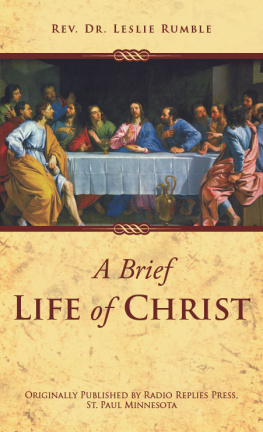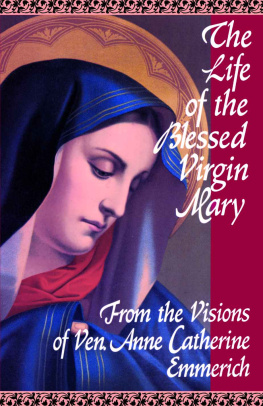Blessed Anne Catherine Emmerich - The Dolorous Passion of Our Lord Jesus Christ (with Supplemental Reading: A Brief Life of Christ) [Illustrated]
Here you can read online Blessed Anne Catherine Emmerich - The Dolorous Passion of Our Lord Jesus Christ (with Supplemental Reading: A Brief Life of Christ) [Illustrated] full text of the book (entire story) in english for free. Download pdf and epub, get meaning, cover and reviews about this ebook. year: 2013, publisher: TAN Books, genre: Science. Description of the work, (preface) as well as reviews are available. Best literature library LitArk.com created for fans of good reading and offers a wide selection of genres:
Romance novel
Science fiction
Adventure
Detective
Science
History
Home and family
Prose
Art
Politics
Computer
Non-fiction
Religion
Business
Children
Humor
Choose a favorite category and find really read worthwhile books. Enjoy immersion in the world of imagination, feel the emotions of the characters or learn something new for yourself, make an fascinating discovery.

- Book:The Dolorous Passion of Our Lord Jesus Christ (with Supplemental Reading: A Brief Life of Christ) [Illustrated]
- Author:
- Publisher:TAN Books
- Genre:
- Year:2013
- Rating:4 / 5
- Favourites:Add to favourites
- Your mark:
- 80
- 1
- 2
- 3
- 4
- 5
The Dolorous Passion of Our Lord Jesus Christ (with Supplemental Reading: A Brief Life of Christ) [Illustrated]: summary, description and annotation
We offer to read an annotation, description, summary or preface (depends on what the author of the book "The Dolorous Passion of Our Lord Jesus Christ (with Supplemental Reading: A Brief Life of Christ) [Illustrated]" wrote himself). If you haven't found the necessary information about the book — write in the comments, we will try to find it.
Blessed Anne Catherine Emmerich: author's other books
Who wrote The Dolorous Passion of Our Lord Jesus Christ (with Supplemental Reading: A Brief Life of Christ) [Illustrated]? Find out the surname, the name of the author of the book and a list of all author's works by series.
The Dolorous Passion of Our Lord Jesus Christ (with Supplemental Reading: A Brief Life of Christ) [Illustrated] — read online for free the complete book (whole text) full work
Below is the text of the book, divided by pages. System saving the place of the last page read, allows you to conveniently read the book "The Dolorous Passion of Our Lord Jesus Christ (with Supplemental Reading: A Brief Life of Christ) [Illustrated]" online for free, without having to search again every time where you left off. Put a bookmark, and you can go to the page where you finished reading at any time.
Font size:
Interval:
Bookmark:



Nihil Obstat: Georgius D. Smith, D.D.
Censor Deputatus
Imprimatur: Edm. Can. Surmont
Vicarius Generalis
Westmonasterii
Die XXI Maii MCMXXVIII
This translation was published circa 1928 by Burns Oates & Washbourne Ltd., London. Another edition of this translation was published in 1968 by The Christian Book Club of America, Hawthorne, California.
Published in 1983 by TAN Books, an Imprint of Saint Benedict Press, LLC. Re-typeset and re-published by TAN Books in 2004. Typography is the property of TAN Books. Footnotes are from the 1928 edition unless annotated thus: Publisher , 2004; footnotes annotated thus were added by TAN Books.
ISBN: 978-0-89555-210-5
Cover illustration: Christ in Gethsemane Altarpiece. Artist: Carl H. Bloch (1834-1890); Hope Gallery, Inc. (Provo, Utah).
Printed and bound in the United States of America.
TAN Books
An Imprint of Saint Benedict Press, LLC
Charlotte, North Carolina
2012
DEDICATION
To the Immaculate Heart of the
Virgin Mary, Mother of God, Queen of Heaven and Earth,
Lady of the Most Holy Rosary, Help of Christians,
and Refuge of the Human Race.
PREFACE TO THE FRENCH TRANSLATION
By the Abb de Cazals
The writer of this Preface was travelling in Germany when he chanced to meet with a book entitled, The History of the Passion of Our Lord Jesus Christ, from the Meditations of Anne Catherine Emmerich , which appeared to him both interesting and edifying. Its style was unpretending, its ideas simple, its tone unassuming, its sentiments unexaggerated, and its every sentence expressive of the most complete and entire submission to the Church. Yet, at the same time, it would have been difficult anywhere to meet with a more touching and lifelike paraphrase of the Gospel narrative. He thought that a book possessing such qualities deserved to be known on this side of the Rhine, and that there could be no reason why it should not be valued for its own sake, independent of the somewhat singular source whence it emanated.
Still the translator has by no means disguised to himself that this work is written, in the first place, for Christians; that is to say, for men who have the right to be very diffident in giving credence to particulars concerning facts which are articles of faith; and although he is aware that St. Bonaventure and many others, in their paraphrases of the Gospel history, have mixed up traditional details with those given in the sacred text, even these examples have not wholly reassured him. St. Bonaventure professed only to give a paraphrase, whereas these revelations appear to be something more. It is certain that the holy maiden herself gave them no higher title than that of dreams, and that the transcriber of her narratives [Clemens Brentano] treats as blasphemous the idea of regarding them in any degree as equivalent to a fifth Gospel; still it is evident that the confessors who exhorted Sister Emmerich to relate what she saw, the celebrated poet who passed four years near her couch, eagerly transcribing all he heard her say, and the German Bishops, who encouraged the publication of his book, considered it as something more than a paraphrase. Some explanations are needful on this head.
The writings of many Saints introduce us into a new, and, if I may be allowed the expression, a miraculous world. In all ages there have been revelations about the past, the present, the future, and even concerning things absolutely inaccessible to the human intellect. In the present day men are inclined to regard these revelations as simple hallucinations, or as caused by a sickly condition of body.
The Church, according to the testimony of her most approved writers, recognizes three descriptions of ecstasy; of which the first is simply natural, and entirely brought about by certain physical tendencies and a highly imaginative mind; the second divine or angelic, arising from intercourse held with the supernatural world; and the third produced by infernal agency. Lest we should here write a book instead of a preface, we will not enter into any development of this doctrine, which appears to us highly philosophical, and without which no satisfactory explanation can be given on the subject of the soul of man and its various states.
The Church directs certain means to be employed to ascertain by what spirit these ecstasies are produced, according to the maxim of St. John: Try the spirits, if they be of God. When circumstances or events claiming to be supernatural have been properly examined according to certain rules, the Church has in all ages made a selection from them.
Many persons who have been habitually in a state of ecstasy have been canonized, and their books approved. But this approbation has seldom amounted to more than a declaration that these books contained nothing contrary to faith, and that they were likely to promote a spirit of piety among the faithful. For the Church is only founded on the word of Christ and on the revelations made to the Apostles. Whatever may since have been revealed to certain Saints possesses purely a relative value, the reality of which may even be disputedit being one of the admirable characteristics of the Church, that, though inflexibly one in dogma, she allows entire liberty to the human mind in all besides. Thus, we may believe private revelations, above all, when those persons to whom they were made have been raised by the Church to the rank of Saints publicly honored, invoked, and venerated; but even in these cases, we may, without ceasing to be perfectly orthodox, dispute their authenticity and divine origin. It is the place of reason to dispute and to select as it sees best.
With regard to the rule for discerning between the good and the evil spirit, it is no other, according to all theologians, than that of the Gospel: A fructibus eorum cognoscetis eos By their fruits you shall know them . It must be examined in the first place whether the person who professes to have revelations mistrusts what passes within himself; whether he would prefer a more common path; whether far from boasting of the extraordinary graces which he receives, he seeks to hide them, and only makes them known through obedience; and, finally, whether he is continually advancing in humility, mortification, and charity. Next, the revelations themselves must be very closely examined into; it must be seen whether there is anything in them contrary to faith; whether they are conformable to Scripture and Apostolical tradition; and whether they are related in a headstrong spirit, or in a spirit of entire submission to the Church.
Whoever reads the life of Anne Catherine Emmerich, and her book, will be satisfied that no fault can be found in any of these respects either with herself or with her revelations. Her book resembles in many points the writings of a great number of Saints, and her life also bears the most striking similitude to theirs. To be convinced of this fact, we need but study the writings or what is related of Saints Francis of Assisi, Bernard, Bridget, Ignatius, John of the Cross, Teresa, and an immense number of other holy persons who are less known. So much being conceded, it is clear that in considering Sister Emmerich to have been inspired by Gods Holy Spirit, we are not ascribing more merit to her book than is allowed by the Church to all those of the same class. They are all edifying, and may serve to promote piety, which is their sole object. We must not exaggerate their importance by holding as an absolute fact that they proceed from Divine inspiration, a favor so great, that its existence in any particular case should not be credited save with the utmost circumspection.
Next pageFont size:
Interval:
Bookmark:
Similar books «The Dolorous Passion of Our Lord Jesus Christ (with Supplemental Reading: A Brief Life of Christ) [Illustrated]»
Look at similar books to The Dolorous Passion of Our Lord Jesus Christ (with Supplemental Reading: A Brief Life of Christ) [Illustrated]. We have selected literature similar in name and meaning in the hope of providing readers with more options to find new, interesting, not yet read works.
Discussion, reviews of the book The Dolorous Passion of Our Lord Jesus Christ (with Supplemental Reading: A Brief Life of Christ) [Illustrated] and just readers' own opinions. Leave your comments, write what you think about the work, its meaning or the main characters. Specify what exactly you liked and what you didn't like, and why you think so.



